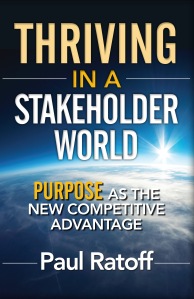To ensure an organization’s long-term success, pursuing purposeful behavior is the best practice business leaders can follow for thriving in today’s stakeholder-driven world.
 “Purposeful behavior means taking actions that are consistent with a purpose that is meaningful and important to all the organization’s stakeholders,” says Paul Ratoff, author of the new book Thriving in a Stakeholder World: Purpose as the New Competitive Advantage (Indie Books International, 2016). Ratoff defines stakeholders in a much broader context; meaning all individuals or groups of individuals who impact or are impacted by the organization.
“Purposeful behavior means taking actions that are consistent with a purpose that is meaningful and important to all the organization’s stakeholders,” says Paul Ratoff, author of the new book Thriving in a Stakeholder World: Purpose as the New Competitive Advantage (Indie Books International, 2016). Ratoff defines stakeholders in a much broader context; meaning all individuals or groups of individuals who impact or are impacted by the organization.
Ratoff has been a successful business consultant in Southern California for the past 35 years, assisting a wide range of middle-market companies plan and manage their growth and success. He is a Certified Management Consultant, Strategic Management Professional and president of Strategy Development Group.
His book demonstrates to business leaders how applying purposeful behavior as a management style can be an effective way to optimize stakeholder value and provide a competitive advantage in their markets.
At the foundation of this approach is having business leaders discover their organization’s true Purpose or Mission. To do that Ratoff recommends five practices:
1. Ask Why? Challenge yourself by continually asking the simple question, “Why is this meaningful and important to me?” until you are inspired. Start with the reason you wanted to go into business in the first place and then ask the “why” question. Keep asking that question until you come to an answer which you find inspiring or moving in some way. Look for a problem your business solved for people.
2. Ask What Really Inspires You. You can also look for actions you would like to take on in your life that inspire you. Something you are doing or might want to do outside of business, if only you had the time or money. Maybe there is a hobby you would love to take on, or a charity you are supporting, or a cause that is important to you. Then, consider how your business might serve as a vehicle to pursue that interest.
3. Think Beyond Business Model. Do not limit yourself to the things your organization does to make money. Purpose and business model are very different. Think of your products and services as byproducts of your organization’s purpose. For example, a company could be committed to creating leaders in the world but it trains and develops its leaders inside of a vertical retail-store/e-commerce business model.
4. Expand on Your Product’s Value. By the same token, the product or service could also be the source of your passion. If that is true, you can use the “why” question to better understand the passion behind it. The value you bring to your customers can be defined as having three levels: There is the physical level of the product or service that is often defined by its specifications and characteristics. There is also the emotional level that is defined by how it affects one personally— for example, how it feels or tastes or comforts. Then there is the conceptual level, which has more to do with how it will impact the world—for example, reduce crime, improve overall health, reduce hunger, etc.
5. Look at Personal Goals. By personal goals, Ratoff is referring to goals that affect you directly: like buying a house, becoming a famous person, etc. Personal goals are very different than purpose. If you consider the time horizon, personal goals are generally achieved in a much shorter time period, say from one to five years. They only need to be inspiring to one person: you. Purpose, on the other hand, would need to have a much longer time horizon, which could extend beyond many generations.
“Purpose needs to be inspiring to many more people, specifically, the organization’s key stakeholders,” says Ratoff. “It is not uncommon for leaders to mistake personal goals as their organization’s purpose. For example, being the largest company in the industry may be a personal goal but it would not likely be an organization’s purpose. It might be a shorter-term goal if it supported the organization’s purpose and business strategy.”
